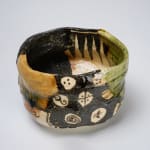Suzuki Goro 鈴木五郎 Japanese, b. 1941
Diameter13.2xH9.1cm
Further images
-
(View a larger image of thumbnail 1
)

-
(View a larger image of thumbnail 2
)

-
(View a larger image of thumbnail 3
)

-
(View a larger image of thumbnail 4
)

-
(View a larger image of thumbnail 5
)

-
(View a larger image of thumbnail 6
)

-
(View a larger image of thumbnail 7
)

-
(View a larger image of thumbnail 8
)

-
(View a larger image of thumbnail 9
)

-
(View a larger image of thumbnail 10
)

-
(View a larger image of thumbnail 11
)

-
(View a larger image of thumbnail 12
)

-
(View a larger image of thumbnail 13
)

-
(View a larger image of thumbnail 14
)

-
(View a larger image of thumbnail 15
)

Goro Suzuki's artistic prowess shines through in his ability to manipulate clay with mastery and create ceramics characterized by a rustic and unpretentious aesthetic. Highly regarded by collectors in Japan and beloved by artists and connoisseurs in the West, Suzuki has enjoyed a career spanning over four decades, evolving from his early days as a production potter to his current status as a revered master ceramist.
Among his most acclaimed techniques are his Oribe, Yobitsugi, and “Goribe" pieces. Inspired by the wonders of nature, including crows, plants, cars, dogs, and more, these motifs come to life under Suzuki's skillful hand, adorning the surfaces of his ceramics with their graceful presence. Suzuki's playful creativity leads him to blend different clays and styles, resulting in a unique fusion he aptly dubs "Goribe." The term "Goribe 五利部" is a clever amalgamation of "go五" from Goro, "ri 利" from Rikyu, and "be 部" from Oribe. This innovative approach allows him to beautifully showcase the various textures through the use of clay and firing techniques.
Suzuki's delightful creations seamlessly unite diverse traditional styles into single, awe-inspiring ceramic pieces. The harmonious coexistence of distinct styles, under Suzuki's expert guidance, renders his Goribe works among the most original contributions to contemporary ceramics.
Achieving this harmonious blend of styles requires meticulous attention during two distinct firing processes: one in a reduction flame and the other in an oxidation flame. Due to the differing requirements of the various glazes, Suzuki applies some before the first firing and others before the second. This intricate process necessitates profound knowledge of both glazing and firing techniques, a testament to Suzuki's confident mastery of the craft. The outcome is a stunning tapestry that beautifully showcases the distinct and recognizable styles of the Japanese ceramic tradition. The Kiseto style, characterized by incised and painted depictions of grasses, flowers, and vegetables on a pale stone-colored background; the abstract yet organic and geometric patterns of the Oribe style, adorned with fields of blue and green glaze; the Shino style, featuring a white background adorned with painted black crows, mountains, and trees; and the deep, matte black of the Seto style, as rich and supple as aged leather and accented with veins of gold—all seamlessly intermingle in Suzuki's work, creating a patchwork quilt of styles that transcends traditional boundaries of form and captivates the eye with its remarkable beauty.














